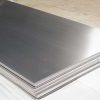310S Stainless Steel Plate Description
Due to the high content of nickel (Ni) and chromium (Cr), 310S stainless steel has good oxidation resistance, corrosion resistance, acid and alkali resistance. After increasing the content of carbon in austenitic stainless steel, the strength is improved due to its solid solution strengthening effect. The chemical composition characteristics of austenitic stainless steel are based on chromium and nickel to add molybdenum, tungsten, niobium and titanium, and because of its face-centered cubic structure, it has high strength and creep strength at high temperatures. 310S stainless steel is often used in the manufacture of boiler, steam turbine, industrial furnace and aviation, petrochemical and other parts of the industry.
Product Parameters
| Product Name | 310S Stainless Steel Plate |
| Type | Plate |
| Thickness | 0.3mm-200mm |
| Length | 2000mm, 2438mm, 3000mm, 5800mm, 6000mm, 12000mm, etc. |
| Width | 40mm-600mm, 1000mm, 1219mm, 1500mm, 1800mm, 2000mm, 2500mm, 3000mm, 3500mm, etc. |
| Standard | ASTM, AISI, JIS, GB, DIN, EN, etc. |
| Surface | BA, 2B, NO.1, NO.4, 4K, HL, 8K, etc. |
| Scope of Application | Widely used in high temperature and electrical industry, medical equipment construction, chemical, food industry, agriculture and ship parts, food and beverage packaging, Kitchen supplies, trains, airplanes, conveyor belts, vehicles, bolts, nuts, springs and screens, etc. |
| Certificate | ISO, SGS, BV, etc. |
| Production Technology | Hot Rolling, Cold Rolling |
| Edge Processing | Edging, Trimming |
Chemical Composition
| C | Si | Mn | Cr | Ni | S | P |
| ≤ 0.08 | ≤1.0 | ≤ 2.0 | 24.0~26.0 | 19.0~22.0 | ≤ 0.03 | ≤ 0.045 |
Mechanical Properties
| Tensile Strength Kb (MPa) | Yield Strength σ0.2 (MPa) | Elongation D5 (%) | Hardness |
| ≥520 | ≥205 | ≥40 | ≤ 217HB;≤ 95HRB |
Physical Performance
| Density(g/cm³) | Modulus of Elasticity(Gpa) | Coefficient of Thermal Expansion(10-6/°C) | Coefficient of Thermal Conductivity(W/m*K) | Resistivity(ΜΩ. cm) |
| 9.01 | 200 | 14.4 | 13.8 | 94 |
Surface Selection











